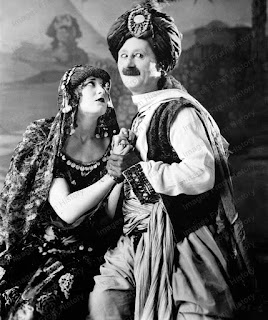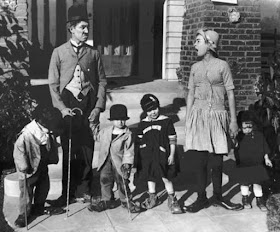The titular horsemen of this programmer are a band of malcontents led by Mac Collins (Charles Starrett), and to help deal with the Collins gang’s deviltry, Texas Ranger Steve Langdon (Charles Starrett) is transferred to a detachment commanded by Captain T.L. Martin (Roy Barcroft). Regarding those cast members in parentheses—it’s not a typo. First, The Baddest Villain in All of Serialdom, Mr. Barcroft, is on the right side of the law for a change. Second, Mac Collins and Steve Langdon look so much alike they could be twins…which is why they’re both played by the same actor.
The striking “Prince and the Pauper” similarities between
Mac and Steve are first discovered by Steve’s fellow Ranger, “Lucky” Barton
(Russell Hayden); Lucky and his new bride Celia (Kay Hughes) have the
misfortune to be on a stagecoach robbed by the Collins mob, and that’s when
Barton thinks: “That Collins looks a lot like a chap I know.” Then tragic events unfold, with Barton swearing
vengeance on Steve because Celia draws her rations after being shot by his
doppelganger during the robbery.
We know, of course, that Steve is perfectly innocent—in fact,
he was in the company of troubadour/part-time dentist “Bones” Malloy (Cliff
Edwards) when the robbery went down. The
trouble is: no one believes Bones’ story (everyone is convinced he was in on
the holdup, too). Lucky, to his credit,
starts to have second thoughts about Steve’s guilt after going all out to make
sure his fellow Ranger is prosecuted to the fullest extent of the law…but since
Langdon has been sentenced to swing, it’s going to be a race against time if
Lucky and Bones are to find the needed evidence to exonerate Steve before his
date with the hangman.
Riders of the
Badlands (1941) was the second of eight Columbia Pictures oaters to team
B-Western cowboys Charles Starrett and Russell Hayden; Hayden was well-known as
a co-star in many of the Hopalong Cassidy westerns produced in the 1930s, while
Starrett joined Columbia in 1935 originally to replace the studio’s reigning
cowboy king Tim McCoy. Curiously,
Starrett wasn’t particularly wild about the Western genre, and originally agreed
to make them for a period of two years…but he became a victim of his own
success, and stayed in the saddle for Columbia until 1952, chiefly on the
strength of his Durango Kid series.
By the time Badlands
went before the cameras, the Durango Kid films numbered just one: 1940’s The Durango Kid. The franchise
didn’t really go great guns (sorry about that) until The Return of the Durango
Kid in 1945, so it’s a shame that it didn’t start earlier because in the
case of Badlands they could have had
four roles for Starrett—Mac, Steve,
and their Durango Kid counterparts.
(Just a thought, mind you.)
I have a special affinity for the B-product put out by the
Columbia folks…probably because they were so good at it; the studio’s origins
were steeped in Poverty Row programmers (Columbia at one time was known as the
CBC Film Sales Corporation; industry wags joked that the “CBC” stood for “Corned
Beef and Cabbage”). I pretty much love
of all the franchises cranked out by Columbia (Boston Blackie, The Whistler,
etc.), and my introduction to slapstick comedy was as a result of my exposure
to two-reelers featuring Andy Clyde and the Three Stooges at an impressionable
age.
So I was predisposed to like Riders of the Badlands…but was pleasantly surprised that it’s a
most enjoyable little shoot-‘em-up.
Starrett and Hayden make an excellent team, and Badlands gets an extra assist from comic relief Cliff “Ukulele Ike”
Edwards; he substitutes his uke for a guitar but sings three songs in his
inimitable style. The lookalikes plot (scripted
by Betty Burbridge) never gets too silly, though Andrew Leal’s mom (I
affectionately refer to her as “Mother Grover”) might engage in a little
eye-rolling if given the opportunity. (As
a side note: co-star Hayden even used the “twin” plot for a 1947 oater released
by Screen Guild Productions, Trail of
the Mounties.) Journeyman Howard
Bretherton (in the chair for several of the early Hoppy westerns, as well as
1933’s Ladies They Talk About) is
credited with the direction, and he does a solid job (he helmed Starrett and
Hayden’s West of Tombstone [1942] for
the studio as well).
Befitting a Columbia production, you’ll spot a number of the
studio’s stock players including Eddie Laughton, John Tyrrell, and Ethan
Laidlaw, plus familiar Westerns faces like Edmund Cobb and George
Chesebro. Young Ilene Brewer plays
Collins’ daughter Flo, a character they created for Badlands to make her outlaw pop more human, I suppose…but there’s a
rather disturbing development at the denouement when we learn Flo is being sent
to a girls’ boarding school (accompanied by second female lead Edith Leach). I’m assuming that her Pa paid for his crimes
but that would mean that he’s taken Steve’s place in the hangman’s noose,
wouldn’t it? She seems a bit calm and
rational for a kid who just lost her Dad.
I obtained Riders of
the Badlands on DVD through curious means: it’s available
at Finders Keepers, my pal Martin Grams, Jr.'s video website…but I didn’t
actually buy this one—I recall he
sent it to me gratis for one reason
or another. I’m glad he did, because it
was most enjoyable…and throughout the first ten minutes of the movie I marveled
at how beautiful a print it was. (Then
the “Encore Westerns” logo appeared on the screen.)














































